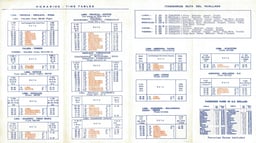Faucett Perú

Faucett Perú

| |||||||
| Founded | 15 September 1928 (1928-09-15) | ||||||
|---|---|---|---|---|---|---|---|
| Commenced operations | 27 September 1928 (1928-09-27) | ||||||
| Ceased operations | December 3, 1997 (1997-12-03) | ||||||
| Hubs |
| ||||||
| Destinations | 17 (at the time of closure) | ||||||
| Company slogan | |||||||
| Headquarters | Jorge Chávez International Airport Lima, Lima Province, Perú | ||||||
| Key people | Elmer J. Faucett | ||||||
Compañía de Aviación Faucett, colloquially known simply as Faucett Perú or Faucett, was a Peruvian airline.
| |||||||
| Founded | 15 September 1928 (1928-09-15) | ||||||
|---|---|---|---|---|---|---|---|
| Commenced operations | 27 September 1928 (1928-09-27) | ||||||
| Ceased operations | December 3, 1997 (1997-12-03) | ||||||
| Hubs |
| ||||||
| Destinations | 17 (at the time of closure) | ||||||
| Company slogan | |||||||
| Headquarters | Jorge Chávez International Airport Lima, Lima Province, Perú | ||||||
| Key people | Elmer J. Faucett | ||||||
History
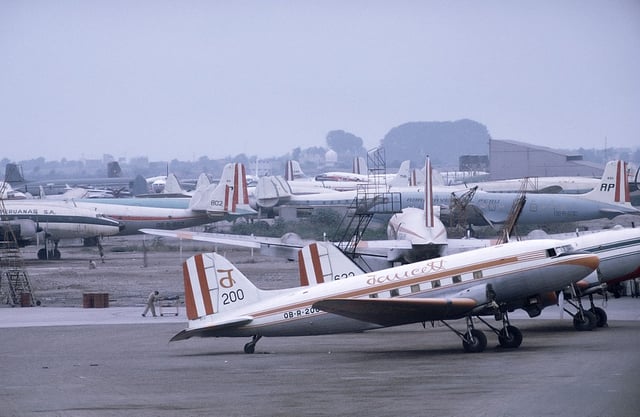
Douglas DC-3 of Faucett at Lima Airport, Peru, in 1972
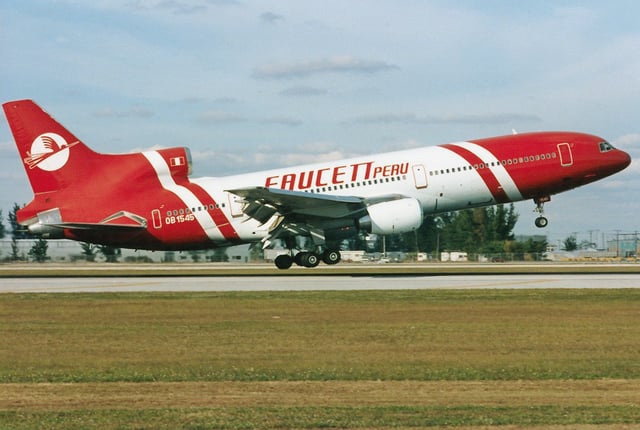
A Faucett Lockheed L-1011-1 at Miami International Airport in 1996.
Elmer J. Faucett had been sent to Peru as a representative of the Curtiss Export Company, arriving in the country from the United States in 1920.[4] [] In 1928, he and a group of Peruvian business men joined together to found the first commercial airline in Peru, and one of the first in Latin America. With an initial investment of £2,500,[4] [] the company was formed on 15 September 1928, and started operations on 27 September that year.[5] In 1937, the airline absorbed Cia de Aviacion Peruanas SA from Panagra.[6] At April 1938 (1938-04), the route network was flown with seven planes manufactured by the Stinson Aircraft Company, and included Chiclayo, Ica, Lima, Sabados and Talara.[7]
Postwar operations
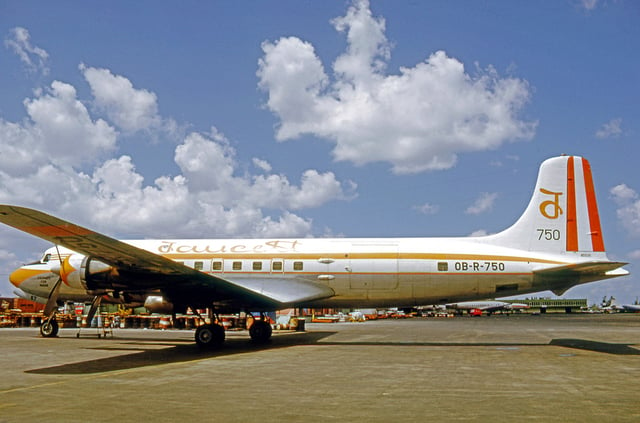
Faucett Douglas DC-6B(F) in 1972 fitted with large rear cargo door for freight operations
By March 1960 (1960-03), the airline had a fleet of eight DC-3s, four DC-4s and four Faucett Stinson F-19s to serve a route network that was 6,368 miles (10,248 km) long.[10] A second-hand Douglas DC-6B acquired from Panagra was incorporated into the fleet in the early 1960s.[6][11] Another DC-6B was acquired in late 1964 and was converted to DC-6B(F) standard with a large rear freight door.[12] This was operated on cargo services to Miami, Florida.
At March 1990 the airline had 1,300 employees and a fleet of ten aircraft that consisted of two Boeing 727-200s, one Boeing 737-100, four Boeing 737-200s and three McDonnell Douglas DC-8-50s.[15]
The 1990s economic liberalization under Alberto Fujimori, after years of economic and political chaos (as well as a violent Maoist insurgency), brought a series of measures aimed at the privatization and deregulation of the airline market. A series of short-lived airlines sprung up during this decade (in the style of Russian Babyflots), stated-owned Aeroperú was partly sold to Mexican investors and the rise of low-fare Aero Continente as the biggest domestic airline, contributed to the slow decline of Faucett. A series of high-profile accidents, especially Faucett's crash in Arequipa and Aeroperú Flight 603 (both in 1996) affected the safety reputation of the Peruvian airline industry, with even the US Embassy in Lima banning their employees from flying on Aero Continente and, more broadly, advising caution to US citizens flying on Peru's airlines.[16]
In the end, problems with the economic-financial structure of the airline (with debts even with CORPAC for airport services), forced it to cease operations on December 3, 1997. Despite claiming that the 45-day closure would be temporary until government approval, all 1,250 employees were dismissed. Faucett incurred over US$1 million in debt.[17] By 1998, the former directors and employees were engaged in legal battles over labor and management issues, as well as accusations over bankrupting the company.[18] The airline was liquidated in 1999.[19][20]
Destinations
Faucett Perú served the following destinations:
| † | Hub |
| ‡ | Focus city |
| Destination served at the time of closure |
| Country (State/Province) | City | Airport | Refs |
|---|---|---|---|
| Perú | Arequipa | Rodríguez Ballón International Airport | [2][21] |
| Ayacucho | Coronel FAP Alfredo Mendívil Duarte Airport | [2][21] | |
| Cajamarca | Mayor General FAP Armando Revoredo Iglesias Airport | [22] | |
| Chiclayo | Cap. FAP José A. Quiñones Gonzáles International Airport | [2][21] | |
| Chimbote | Tnte. FAP Jaime Montreuil Morales Airport | [22] | |
| Cuzco | Alejandro Velasco Astete International Airport | [2][21] | |
| Huánuco | Alférez FAP David Figueroa Fernandini Airport | [22] | |
| Iberia | Iberia Airport | [22] | |
| Ilo | Ilo Airport | [2] | |
| Iquitos | Crnl. FAP Francisco Secada Vignetta International Airport | [2][21] | |
| Juliaca | Inca Manco Cápac International Airport | [2][21] | |
| Lima | Jorge Chávez International Airport† | [2][21] | |
| Mollendo | Mollendo Airport | [22] | |
| Moyobamba | Moyobamba Airport | [22] | |
| Piura | Cap. FAP Guillermo Concha Iberico International Airport | [2][21] | |
| Pucallpa | FAP Captain David Abenzur Rengifo International Airport | [2][21] | |
| Puerto Maldonado | Padre Aldamiz International Airport | [1] | |
| Quince Mil | Quince Mil Airport | [22] | |
| Rioja | Juan Simons Vela Airport | [2][21] | |
| Tacna | Crnl. FAP Carlos Ciriani Santa Rosa International Airport‡ | [2][21] | |
| Talara | Cap. FAP Víctor Montes Arias Airport | [2][21] | |
| Tarapoto | Cad. FAP Guillermo del Castillo Paredes Airport | [2][21] | |
| Tingo María | Tingo María Airport | [22] | |
| Trujillo | Cap. FAP Carlos Martínez de Pinillos International Airport | [2][21] | |
| Tumbes | Cap. FAP Pedro Canga Rodríguez Airport | [2][21] | |
| Yurimaguas | Moisés Benzaquén Rengifo Airport | [2][21] | |
| United States (Florida) | Miami | Miami International Airport | [2][21] |
Fleet
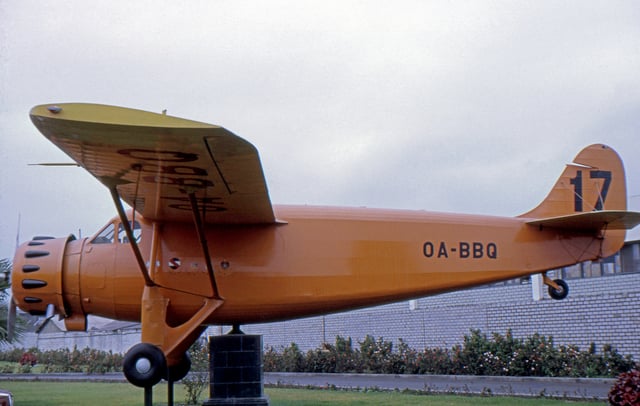
Faucett-Stinson F.19 cargo aircraft built by Faucett, exhibited at their base at Lima in April 1972
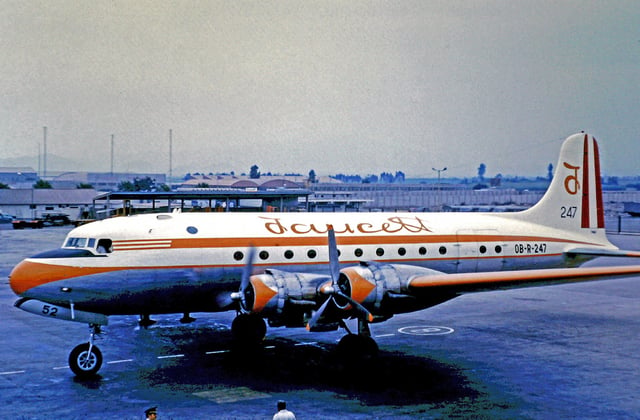
Douglas DC-4 of Faucett operating an internal Peruvian passenger service from Lima Airport in 1972
Faucett Perú operated the following equipment all through its history:[23]
Airbus A300B4[24]
Airbus A300-600
BAC One-Eleven 475
BAC One-Eleven 500
Boeing 707-320
Boeing 707-320B
Boeing 707-320C
Boeing 720
Boeing 727-100
Boeing 727-100C
Boeing 737-100
Boeing 737-200
Douglas DC-3
Douglas DC-3A
Douglas DC-4
Douglas C-47A
Douglas C-47B
Douglas C-53
Douglas C-54
Douglas DC-6B
Douglas DC-8-30
Douglas DC-8-40
Douglas DC-8-50
Douglas DC-8-60
Faucett Stinson F-19[10]
Lockheed L-1011-1
Incidents and accidents
On December 8, 1967, a Faucett Douglas DC-4 airliner crashed into a mountain in the Andes at 10,470 feet, killing all 66 passengers and six crew.[26]
On September 11, 1990, a Faucett Boeing 727-246 went missing some 350 miles southeast of Cape Race Newfoundland. After having been leased to Air Malta, the aircraft was being returned to Peru from Europe via Iceland, when the crew reported a low fuel notice and that they were preparing to ditch. There were no survivors among 16 occupants on board.[27]
On February 29, 1996, Faucett Flight 251, a Boeing 737 leased from American Airlines, crashed in the mountains near Arequipa's airport, killing all 117 passengers and 6 crew aboard.[28]
See also
List of airlines of Peru
Transport in Peru
